
The Jurassic is a geologic period and stratigraphic system that spanned from the end of the Triassic Period 201.4 million years ago (Mya) to the beginning of the Cretaceous Period, approximately 145 Mya. The Jurassic constitutes the middle period of the Mesozoic Era as well as the eighth period of the Phanerozoic Eon and is named after the Jura Mountains, where limestone strata from the period were first identified.

Cycads are seed plants that typically have a stout and woody (ligneous) trunk with a crown of large, hard, stiff, evergreen and (usually) pinnate leaves. The species are dioecious, that is, individual plants of a species are either male or female. Cycads vary in size from having trunks only a few centimeters to several meters tall. They typically grow slowly and have long lifespans. Because of their superficial resemblance to palms or ferns, they are sometimes mistaken for them, but they are not closely related to either group. Cycads are gymnosperms (naked-seeded), meaning their unfertilized seeds are open to the air to be directly fertilized by pollination, as contrasted with angiosperms, which have enclosed seeds with more complex fertilization arrangements. Cycads have very specialized pollinators, usually a specific species of beetle. Both male and female cycads bear cones (strobili), somewhat similar to conifer cones.
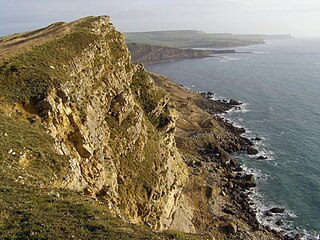
The Jurassic Coast is a World Heritage Site on the English Channel coast of southern England. It stretches from Exmouth in East Devon to Studland Bay in Dorset, a distance of about 96 miles (154 km), and was inscribed on the World Heritage List in mid-December 2001.

Pliosauroidea is an extinct clade of plesiosaurs, known from the earliest Jurassic to early Late Cretaceous. They are best known for the subclade Thalassophonea, which contained crocodile-like short-necked forms with large heads and massive toothed jaws, commonly known as pliosaurs. More primitive non-thalassophonean pliosauroids resembled plesiosaurs in possessing relatively long necks and smaller heads. They originally included only members of the family Pliosauridae, of the order Plesiosauria, but several other genera and families are now also included, the number and details of which vary according to the classification used.
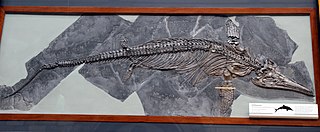
Ichthyosaurus is a genus of ichthyosaurs from the Early Jurassic of Europe. Some specimens of the ichthyosaurid Protoichthyosaurus from England and Switzerland have been erroneously referred to this genus in the past. It is among the best known ichthyosaur genera, as it is the type genus of the order Ichthyosauria.

The Middle Jurassic is the second epoch of the Jurassic Period. It lasted from about 174.1 to 161.5 million years ago. Fossils of land-dwelling animals, such as dinosaurs, from the Middle Jurassic are relatively rare, but geological formations containing land animal fossils include the Forest Marble Formation in England, the Kilmaluag Formation in Scotland, the Calcaire de Caen of France, the Daohugou Beds in China, the Itat Formation in Russia, the Tiouraren Formation of Niger, and the Isalo III Formation of western Madagascar.
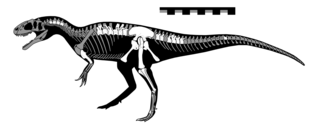
Gasosaurus is a genus of tetanuran theropod that lived approximately 171.6 to 161.2 million years ago during the middle of the Jurassic Period. The name "Gasosaurus" is derived from the English "gasoline" and the Greek σαῦρος. Only one species is currently recognised, G. constructus, from which the specific name honours the gasoline company that found the Dashanpu fossil quarry in Sichuan Province, China, now named as the Lower Shaximiao Formation.
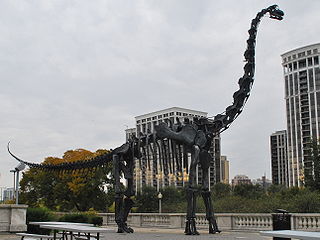
The Brachiosauridae are a family or clade of herbivorous, quadrupedal sauropod dinosaurs. Brachiosaurids had long necks that enabled them to access the leaves of tall trees that other sauropods would have been unable to reach. In addition, they possessed thick spoon-shaped teeth which helped them to consume tough plants more efficiently than other sauropods. They have also been characterized by a few unique traits or synapomorphies; dorsal vertebrae with 'rod-like' transverse processes and an ischium with an abbreviated pubic peduncle.

Eocursor is genus of basal ornithischian dinosaur that lived in what is now South Africa during the Early Jurassic. Remains of this animal have been found in the Upper Elliot Formation and it is among the most completely known early ornithischians, shedding new light on the origin of the group.

Paracryptodira is an extinct group of reptiles in the clade Testudinata, known from the Jurassic to Paleogene of North America and Europe. Initially treated as a suborder sister to Cryptodira, they were then thought to be a very primitive lineage inside the Cryptodira according to the most common use of the latter taxon. They are now often regarded as late-diverging stem-turtles, lying outside the clade formed by Cryptodira and Pleurodira. Paracryptodires are divided into three main groups, Compsemydidae, known from the Late Jurassic to Paleocene of North America and Europe, Pleurosternidae, known from the Late Jurassic to Early Cretaceous of North America and Europe, and Baenidae, known from the Early Cretaceous to Eocene of North America. The latter two groups are more closely related to each other than to Compsemys, forming the clade Baenoidea.

Liparoceras is an extinct fossil ammonite species from the Early Jurassic period of England, and is found in lower Lias deposits. Its name means 'fat head' and this is due to its broad shell. The venter is wide and finely ribbed with no keel and it has two rows of tubercules on each whorl.

The Blue Lias is a geological formation in southern, eastern and western England and parts of South Wales, part of the Lias Group. The Blue Lias consists of a sequence of limestone and shale layers, laid down in latest Triassic and early Jurassic times, between 195 and 200 million years ago. The Blue Lias is famous for its fossils, especially ammonites.

Saurorhynchus is an extinct genus of carnivorous bony fish that lived during the Early and Middle Jurassic epochs. Fossils have been found in Europe and North America (Canada). It is commonly found in pelagic and lagoonal deposits, but mostly marine. Largest specimens can grow up to 1.9 metres (6.2 ft).

The Whitby Mudstone is a Toarcian geological formation in Yorkshire and Worcestershire, England. The formation, part of the Lias Group, is present in the Cleveland and Worcester Basins and the East Midlands Shelf.

Juramaia is an extinct genus of a therian mammal, possibly a very basal eutherian mammal, known from the Late Jurassic or Early Cretaceous deposits of western Liaoning, China. It is a small shrew-like mammal weighing around 15–17 grams (0.53–0.60 oz).

Palaeomedusa testa is an extinct species of thalassochelydian turtle from the Tithonian of the Late Jurassic. It was first described by the German palaeontologist Christian Erich Hermann von Meyer in 1860. It is the only species classified under the genus Palaeomedusa.

Achelonia is an extinct genus of marine thalassochelydian turtle. Its type species is Achelonia formosa. Fossils are known from the Upper Jurassic of Wattendorf, Germany, within Cerin, France, and also in England. Material from England was originally considered to belong to the separate genus Enaliochelys and species Enaliochelys chelonia, named by Harry Govier Seeley in 1869 for a partial disarticulated skeleton from the early Kimmeridgian of the Kimmeridge Clay in Cambridgeshire. The synonymy was recognised in 2020.
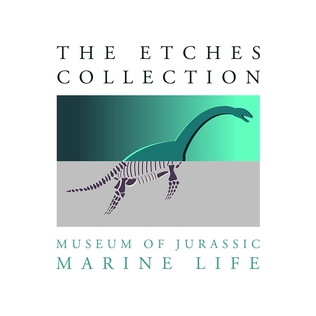
The Etches Collection is an independent fossil museum located in the village of Kimmeridge, Dorset, England. It is based on the lifetime collection of Steve Etches, a fossil hunter for whom some of his finds have been named, from the local area on the Jurassic Coast, a SSSI and World Heritage Site, especially around Kimmeridge Bay and the Kimmeridge Ledges.

Palaeoxonodon is an extinct genus of cladotherian mammal from the Middle Jurassic of England and Scotland.
Pandoravenator is a genus of basal tetanuran theropod dinosaur from the Late Jurassic of central Patagonia. Fossils in the form of a fragmentally preserved postcranial skeleton of this dinosaur were discovered and scientifically described in 2017 by paleontologists Oliver Rauhut and Diego Pol.

















